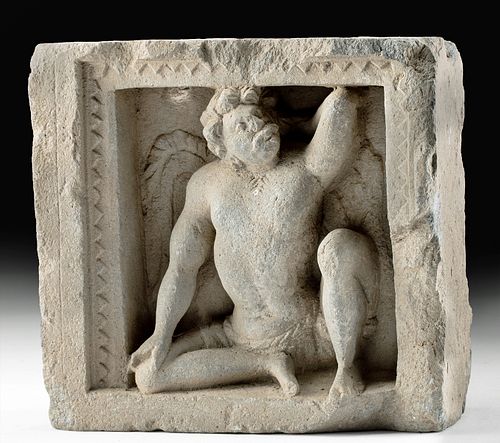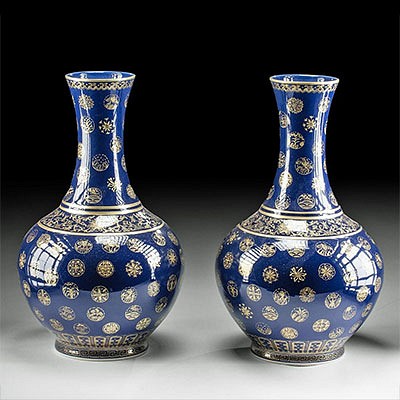Gandharan Schist Block with Atlas
Lot 76
About Seller
Artemis Fine Arts
686 S Taylor Ave, Ste 106
Louisville, CO 80027
United States
Selling antiquities, ancient and ethnographic art online since 1993, Artemis Gallery specializes in Classical Antiquities (Egyptian, Greek, Roman, Near Eastern), Asian, Pre-Columbian, African / Tribal / Oceanographic art. Our extensive inventory includes pottery, stone, metal, wood, glass and textil...Read more
Categories
Estimate:
$3,500 - $4,500
Absentee vs Live bid
Two ways to bid:
- Leave a max absentee bid and the platform will bid on your behalf up to your maximum bid during the live auction.
- Bid live during the auction and your bids will be submitted real-time to the auctioneer.
Bid Increments
| Price | Bid Increment |
|---|---|
| $0 | $25 |
| $300 | $50 |
| $1,000 | $100 |
| $2,000 | $250 |
| $5,000 | $500 |
| $10,000 | $1,000 |
| $20,000 | $2,500 |
| $50,000 | $5,000 |
| $100,000 | $10,000 |
| $200,000 | $20,000 |
About Auction
By Artemis Fine Arts
May 6, 2021
Set Reminder
2021-05-06 10:00:00
2021-05-06 10:00:00
America/New_York
Bidsquare
Bidsquare : Art of Asia | Antiquity to Present
https://www.bidsquare.com/auctions/artemis-gallery/art-of-asia-antiquity-to-present-6908
Featuring antiquities and works of art ranging from the third millennium BCE to the present. From West to East including the Near East and Central Asia, China, Japan, Korea and South and Southeast Asia. Including jades, bronzes, lacquer, textiles, paintings, prints, sculpture, ceramics, more! Artemis Fine Arts info@artemisgallery.com
Featuring antiquities and works of art ranging from the third millennium BCE to the present. From West to East including the Near East and Central Asia, China, Japan, Korea and South and Southeast Asia. Including jades, bronzes, lacquer, textiles, paintings, prints, sculpture, ceramics, more! Artemis Fine Arts info@artemisgallery.com
- Lot Description
Central Asia, Afghanistan, Gandhara, ca. 3rd to 5th century CE. A deeply carved, high relief grey schist panel depicting the Greek Titan Atlas in a dynamic pose as he holds up his left arm to support the ceiling above him and places his weight on his right. The muscular deity is shown seated with his right leg folded to his side and his left knee propped up before him. He is dressed in a loin cloth and exhibits strong shoulders, powerful pectorals, and an attenuated waist. Capped by thick, luscious waves, his visage is angled upward to his left, displaying almond-shaped eyes beneath an arched brow, a bulbous nose, and a lengthy moustache above a pair of petite, closed lips. Note his magnificent wings, shown in low relieve behind him and pluming outwards - a frequent characteristic of Atlas in artistic tradition of ancient Gandhara. The wonderful deity is enveloped by a lovely zigzag border and an indecipherable mason's mark can be found on the verso of the piece. An exceptional example - rich with Classical attributes, Gandharan iconography, and artistic virtuosity! Size: 6" L x 3.125" W x 5.625" H (15.2 cm x 7.9 cm x 14.3 cm)
When the Titans were defeated, many of the Titanomachy including Menoetius were confined to Tartarus, but Atlas was sent to stand at the edge of Gaia (Earth) and hold up the Heavens on his shoulders. This was Zeus' order so that the pair would not be able to resume their primordial embrace. The Greco-Buddhist stylization of Atlas depicts him with enormous, billowing wings, which imbue him with a super-human appearance.
The Gandharan Empire made itself wealthy in part by controlling lucrative trade along the mountain passes between China in the East and the Near East and Mediterranean in the West; a great deal of this wealth went into local patronage of artisans and art. In the first century CE, Buddhism became fashionable amongst Gandharan elites, and the art produced at this time depicting the Buddha includes some of the most striking Buddhist images from the past. Their artistic tradition also reflects the conquest of Alexander the Great and the introduction of styles from all sides, blended into a uniquely Gandharan tradition, which this depiction of Atlas exemplifies.
This piece has been searched against the Art Loss Register database and has been cleared. The Art Loss Register maintains the world’s largest database of stolen art, collectibles, and antiques.
Provenance: private Vero Beach, Florida, USA collection; ex-private England, UK collection, acquired in the 1980s
All items legal to buy/sell under U.S. Statute covering cultural patrimony Code 2600, CHAPTER 14, and are guaranteed to be as described or your money back.
A Certificate of Authenticity will accompany all winning bids.
We ship worldwide and handle all shipping in-house for your convenience.
#163784Losses to lower right corner and top of periphery. Chips to periphery. Expected light nicks and abrasions, as well as some softening of detail, all commensurate with age. Otherwise excellent with light earthen deposits in recessed areas.Condition
- Shipping Info
-
All shipping is handled in-house for your convenience. Your invoice from Artemis Gallery will include shipping calculation instructions. If in doubt, please inquire BEFORE bidding for estimated shipping costs for individual items.
-
- Buyer's Premium



 EUR
EUR CAD
CAD AUD
AUD GBP
GBP MXN
MXN HKD
HKD CNY
CNY MYR
MYR SEK
SEK SGD
SGD CHF
CHF THB
THB













